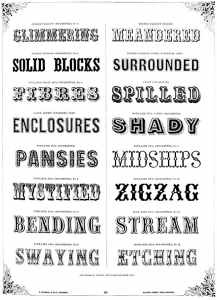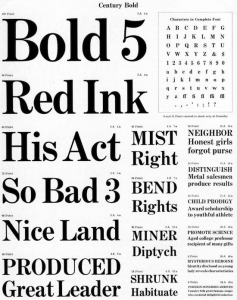Wesley De Jesus
ARTH 3311
Midterm
Professor Trofimova
The Typology of two Era’s
The Industrial Revolution and The Arts and Craft Movement both caused huge changes in the Designer world. One of the changes would be how they both affected typology. Victorian typography. This font lead to help advertise the many products that were made during that era. While in the Arts and Craft Movement, a man named Morris F. Benton who completed a total of 221 typefaces. Ranging from the revival of old fonts to adding different weights to them.
A brief history of both the Industrial Revolution and the Arts and Craft movement. First the Industrial Rev., it started on 1760 and ended around 1840. This era brought about social and economic changes. The steam engine was made and that lead to an increase in factories. Which helped increase city population because people form the country went to the city looking for jobs in the factories. This lead to an increase in city population and production speed of different products because of the increase in product they needed advertisement which leads to an increase in graphic designers and a lot of changes to the designer world like the printing press and metal type pieces.
The Arts and Craft movement started in the US and Britain between 1880 and ended around 1920. The Art’s & Craft movement had started due to people not agreeing with the Industrial Revolution and all the mechanization it brought. The Arts and Craft movement was more about the way a person lives and less about an aesthetic style like how the industrial revolution has Gothic style.
The first image shows an example of Victorian typography. Victorian type are typefaces that have elaborate ornate and embellishments created by several different people. While the second images are a few examples of typefaces that Benton worked on. Although they both have different intentions when it came to creating their fonts. Benton wanted an overall consistency in size, width, and weight. While Victorian typography a variation in size, width, and weight. Though they had different ideas when it came to creating their fonts they did have the intentions of creating new fonts and reviving the fonts.
In conclusion, both of these typographers wanted to make types in order for other people to use these fonts for many different reasons. Though they had different concepts they had the same intentions.
Source:
- https://visualartsdepartment.wordpress.com/the-victorian-era/
- https://en.wikipedia.org/wiki/Morris_Fuller_Benton
- http://www.historygraphicdesign.com/industrial-revolution/the-arts-and-crafts-movement/392-morris-f-benton
- http://www.theartstory.org/movement-arts-and-crafts.htm
- Megg. History of Graphic Design.




